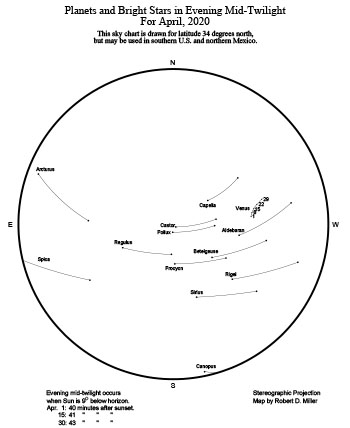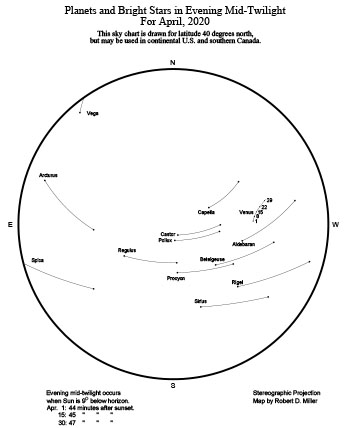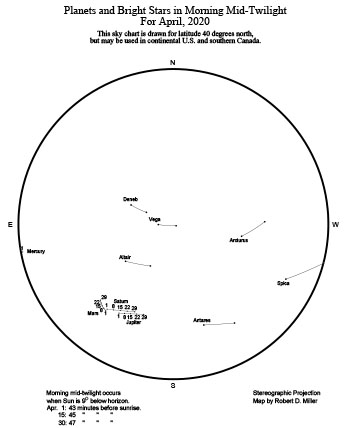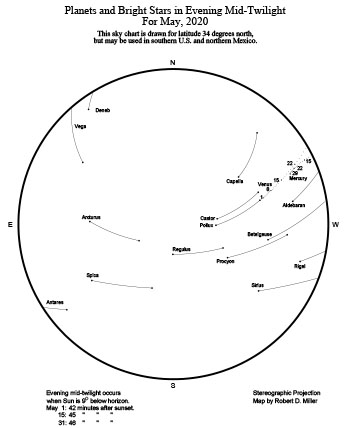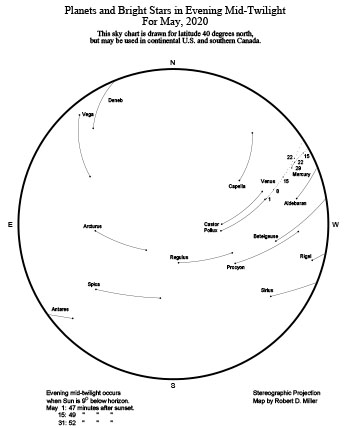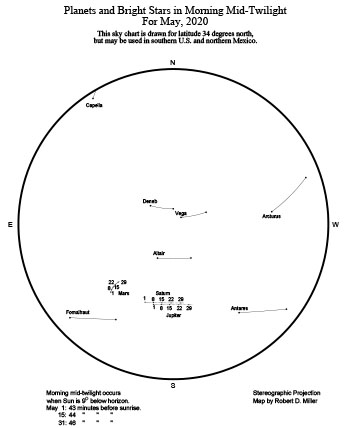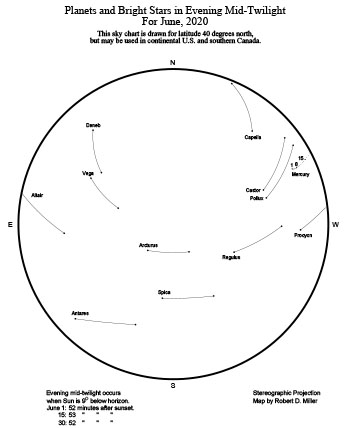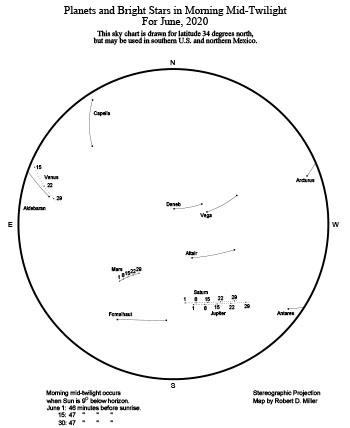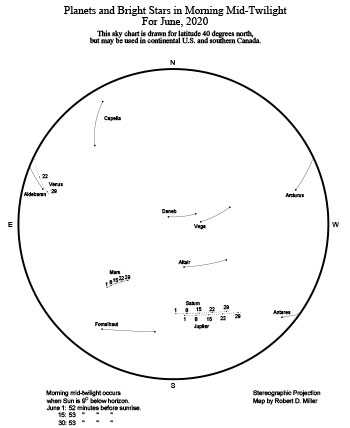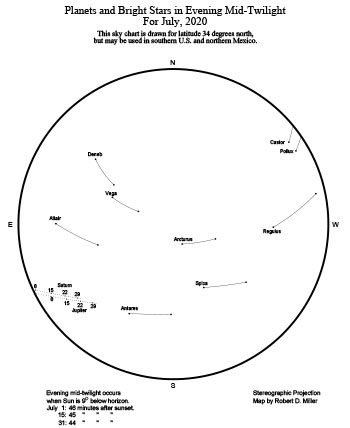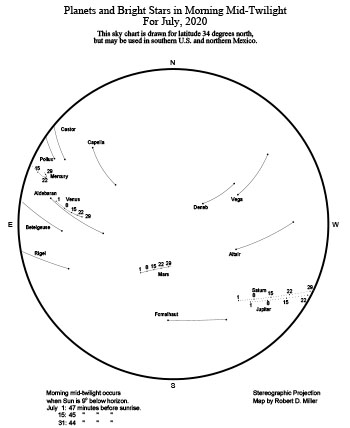Follow the planets, April through July 2020
By Robert C. Victor
Announcement:
April and May Sky Calendars and evening sky maps available free, online
To encourage teachers, students and their families, and others to enjoy the skies during this difficult time of school closures and social distancing, Abrams Planetarium at Michigan State University has placed the April and May 2020 issues of Sky Calendar, including their evening star maps, online.
I recommend the article, Lessons From the Dark: How the Night Can Help Us Cope with Crisis.
Summary of planet visibility – April through July 2020, and beyond
In the evening sky, Venus shines at peak brilliance in April, while setting in a dark sky more than three hours after sunset. In May, Venus drops dramatically, disappearing into bright twilight before month’s end. On its way down, Venus on May 21 has a fast-changing, close encounter in WNW at dusk with Mercury, which just emerged into easy naked-eye visibility about a week earlier. You could regard the dates May 14-28 as a “changing of the guard,” the replacement of Venus by Mercury. But Mercury’s evening apparition, although that planet’s best of the year, setting near end of twilight for several days around May 31, ends quickly as Mercury fades in June’s second week. With Mercury’s departure, the evening sky in mid-June is planet-less, unless you’re willing to stay up late to watch the rising of Jupiter and Saturn in ESE, some two hours after sunset on June 18. The good news is that Jupiter and Saturn will rise about half an hour earlier per week, so by the dates of their respective oppositions, on the nights of July 13 and 20, they’ve just risen by sunset, and the beautiful pair of giant planets will be in ESE to appreciate in the deep blue sky opposite to the Sun as darkness descends.
After their oppositions in July, Jupiter and Saturn will remain visible in the evening sky through the rest of this year, until early in January 2021. They’ll cross through the southern sky near the end of evening twilight in the latter half of September. Throughout the fall of 2020, watch Jupiter close in on Saturn until their rare and exciting, extremely close conjunction on December 21, when they’ll appear just 0.1° apart, low in SW sky at dusk, while Mars shines high in SE.
During April through September 2020, Mars is best seen in the morning sky. But at the end of July, Mars can also be seen in late evening, rising more than three hours after sunset. The red planet’s rising time shifts gradually earlier in the night, and by the latter half of September it rises in the east during evening twilight. Closest approach to Earth on October 6, the best until 2035, and the opposition on October 13 will be an exciting time to observe Mars, as it will rise around sunset and be in good position for evening viewing, while reaching a peak brilliance brighter than Jupiter at the time. After opposition, Mars remains in the evening sky, fading, until it sinks into the western twilight glow in July 2021.
Morning sky: If you enjoy being outdoors in the cool of the morning, perhaps to walk the dog, or intentionally to enjoy the predawn sky, then centering your outings around one hour before sunrise will provide you many planetary visual treats this spring and early summer.
From April 28 through June 6, Jupiter and Saturn remain within 5° apart, drifting across the southern sky from SSE to SSW, while moving little against the background stars of eastern Sagittarius/western Capricornus. Mars moves east against the background, going from eastern Capricornus well into Aquarius between those dates, widening its distance east of Saturn from 18° to 45°, yet strangely staying fixed in the southeast those 40 mornings, while the zodiac background seems to scroll westward behind, brightening Mars.
Venus adds impressive brilliance to the predawn planetary panorama by mid-June. It hangs in ENE, 9° below the Pleiades star cluster for two weeks, June 14-27, as both rise a few minutes earlier each morning, into a darker predawn sky. Starting on July 1, Venus slowly moves across the Hyades star cluster until passing just 1° N of Aldebaran July 11 and 12. By then, Jupiter and Saturn are nearly at opposition, so they’re getting low in southwest.
If you’re looking one hour before sunrise and you have unobstructed views, then Jupiter and Saturn will remain above your horizon for several days after their oppositions of July 14 and 20. Meanwhile, Mars is high in SSE. On July 16 and 17, a waning crescent Moon forms beautiful gatherings with Venus, Aldebaran and the Hyades star cluster, and on July 18 and 19, the thin old Moon appears near Mercury, as the innermost planet brightens low in ENE and emerges from the Sun’s glare. For several mornings in late July, it’s possible to observe all five bright planets above the horizon simultaneously. Detailed daily descriptions are given below, in the section on July mornings.
Mornings beyond July 2020: Mercury, heading toward the far side of the Sun, departs from the morning sky by the second week of August. Jupiter and Saturn depart by setting earlier each morning. By mid-August, both giant planets set before the start of morning twilight, leaving only Venus and Mars. Mars reaches opposition in October, and will set before the start of morning twilight by later that month. Mercury has a return engagement to the dawn sky in November, to the lower left of Venus, but sinks back into bright twilight near the month’s end. Venus holds on the longest. If you’re looking an hour before sunrise, then it will depart in January 2021. Using binoculars and looking closer to the time of sunrise, you can keep seeing Venus until early February. Superior conjunction on the far side of the Sun occurs March 26, 2021.
Sky events, month-by-month, evening and morning
April
April evening sky:
Venus is in W to WNW at dusk in April, reaching peak brilliance. Centered on its passage between Earth and Sun in early June, Venus remains against the fascinating backdrop of Taurus for over four months, from late March until early August. Venus appeared very close to the Pleiades cluster on April 3, passes a wide 10° N of Aldebaran on April 14, and ends month 3.7° lower right of 1.7-mag. Elnath (Beta Tauri, tip of Bull’s northern horn). There’ll be a quasi-conjunction, with Venus stopping short 1.5° from Beta Tauri May 9-12, before turning retrograde.
A waxing crescent Moon will appear near Aldebaran and the Hyades cluster on Saturday, April 25, and near Venus on Sunday, April 26. Best time to look is about 1¼ to 1½ hours after sunset. For these and similar events, see the illustrations on Sky Calendar.
In April and May, as Venus draws closer to Earth, it displays ever thinner and larger crescent phases through telescopes. As Venus reaches peak brilliance in late April, the crescent has become large enough in apparent size to resolve even in low-power binoculars (6x-8x), provided you look in the daytime or soon after sunset, before the contrast of brilliant Venus against a darkened sky makes the crescent too difficult to resolve with such low magnification.
Depicted in the western sky on April’s evening sky maps (both the twilight chart and the more detailed Sky Calendar version), in addition to Venus, are seven stars of first magnitude or brighter. They form the Winter Hexagon, in clockwise order, Sirius, Procyon, Pollux (accompanied 4.5° away by his fainter twin, Castor, of mag. 1.6), Capella, Aldebaran, Rigel, and back to Sirius, with Betelgeuse inside. All appear lower each night at dusk. Four stars, in order of departure, Rigel, Aldebaran, Sirius, and Betelgeuse, followed by the planet Venus, will all be gone by late in May. It would be a worthwhile exercise for students learning about changes in the sky to check for these objects nightly within about an hour after sunset, keeping records of times and dates when each is seen.
Regulus, heart of Leo, climbs high in the south in April’s evening twilight, and golden Arcturus ascends in E to ENE. To Arcturus’ lower right at dusk, find blue-white Spica. As Earth passes between Spica and Sun on April 13, Spica stands at opposition and is visible almost all night: Low in ESE at dusk, high in S in middle of night, and low in WSW at dawn.
Can you spot Vega low in NE during evening twilight by late April? It’s the first star of the Summer Triangle to appear above the horizon.
Easy chance to spot Venus in daytime: At sunset on April 26, find Venus at peak brilliance, mag. –4.7, about 7° to the right of the 15-percent crescent Moon and a little lower. The Venus crescent, 28 percent full and 37 arcseconds across, is now large enough to detect the shape with a steadily held pair of binoculars.
Until its departure for the season in mid-May, keep checking Betelgeuse, the bright reddish star above Orion's belt. By early April this future supernova candidate had recovered to better than magnitude +1.0, noticeably brighter than its +1.7 historic low ebb in Jan.-Feb., when it was a close match to Bellatrix, Orion's other shoulder.
April morning sky:
Bright Jupiter, Saturn, and Mars appear in the southeast sky in April, in a gathering slowly widening as Mars moves to the east (left) of the giant planets. Best time to look is about 1¼ to 1½ hours before sunrise. The waning Moon passes these three bright outer planets April 14-16.
The gap between Jupiter and Saturn is 6° on April 6, closing to 5° by April 28. Mars moves rapidly east against background stars, increasing its distance east of Saturn from 1.0° on April 1 to 20° on May 1. On April mornings, we find stars in locations similar to where we’ll find them in late August and early September at dusk: Summer Triangle approaching overhead, Arcturus in west, Antares in SW, and Spica setting in WSW.
May
May evening sky:
Even in ordinary years, May evenings are a time of rapid change, with the departure of most of the bright winter stars as described above, under April. But evenings in May 2020 feature the dramatic departure of Venus -- watch it get noticeably lower each night until it disappears into bright twilight in the month's final days -- and the fast emergence of Mercury from the far side of the Sun around mid-month. Venus in the foreground, and Mercury in the background, moving in opposite directions, speed past each other on May 21. That evening, they’re just 1.0° apart for California sky watchers. Don’t miss large, thin crescent Venus and tiny, gibbous Mercury in the same low-power telescope field of view! Day-by-day changes in the arrangement of Venus and Mercury for several evenings before and after are depicted on the May Sky Calendar. Remember to catch the compact gathering of the young crescent Moon, Venus, and Mercury low in very early evening twilight on May 23. Select a place where a mountain or a nearby obstruction won’t block your view.
At month’s end, the only bright objects remaining in the low western sky in deepening twilight are the “Gemini Arch” in W to WNW, consisting of, from left to right, Procyon, Pollux, Castor, and Capella, with Mercury below. Leo’s brightest star Regulus at the end of May is still well up in WSW. The Big Dipper’s curved handle points the way to Arcturus high in ESE and Virgo’s brightest star Spica well up in SSE: “Follow the arc to Arcturus, and drive a spike to Spica.” The second member of the Summer Triangle to rise, Deneb, appears very low in NE, to the lower left of bright Vega. Finally, locate the red supergiant star Antares, heart of the Scorpion, low in SE at dusk in late May. As Earth passes between Antares and Sun on night of May 30-31, Antares stands at opposition and is visible almost all night: Low in SE at dusk, at its highest in S in middle of night, and low in SW at dawn.
May morning sky:
Morning twilight chart shows bright Jupiter in the southern sky, and Saturn in quasi-conjunction within 5° to Jupiter’s east (left) all month (min. dist. 4.7° on May 18, just days after both planets begin retrograde). Brightening Mars is in SE, 20° to 41° lower left of Saturn. Watch Moon pass the three bright outer planets May 12-16, as depicted on May Sky Calendar. Bright stars are the Summer Triangle of Vega, Altair, and Deneb overhead, Arcturus sinking in W to WNW, Antares sinking in SW, and Fomalhaut in SE, below Mars.
June
June evening sky:
Mercury on June 1 is of mag. +0.2 and near peak altitude for this apparition, low in WNW evening twilight, below the “Gemini Arch” of Procyon, Pollux, Castor, and Capella. The innermost planet fades to +1.1 by June 10, when it’s 12° below the sinking Twins and completes an isosceles triangle with them. Thereafter, Mercury quickly fades, and sinks into bright twilight. Regulus is high in WSW to W, Spica and Arcturus pass through their highest points in the south, and Antares, past opposition, ascends in the southeast. Altair rises north of east to complete the Summer Triangle with Vega and Deneb farther north, to its upper left.
At the end of June, in ESE, Jupiter rises a bit less than an hour after sunset, and Saturn a bit more than an hour, about 20 minutes apart. You can spot them higher in SE later in evening, or highest in the south near 3:00 a.m. PDT, or in SW as dawn brightens.
June morning sky:
June mornings feature the emergence of Venus in the east (see below), and the giant planets Jupiter and Saturn 4.9° to 6.0° apart in S to SW, with brighter Jupiter the western member of the pair. Mars, brightening from mag. 0.0 to –0.5, is in SE, 41° to 61° E of Saturn. Early this month, Mars lies directly ahead of Spaceship Earth in our pursuit of the red planet, and later in the month displays its minimum gibbous phase, 84 percent full. (We will overtake Mars, and it will appear at opposition and be visible all night, on October 13.)
The Summer Triangle of Vega, Altair, and Deneb passes overhead, chasing Arcturus and Antares below the western horizon. Fomalhaut, mouth of the Southern Fish, approaches its highest position, in the south.
Welcome Venus! After passing inferior conjunction, nearly between Earth and Sun, on June 3, Venus climbs quickly into the morning sky, to the upper right of the rising Sun. By June 13, it’s easy for the unaided eye, but very low, at morning mid-twilight. Even a few days before that date, you can use binoculars to pick out Venus’ very thin crescent in a brighter sky. While Venus is less than 15° from the Sun before June 13, protect your eyes by blocking the Sun with a building, or looking before sunrise. By June 15, Venus rises an hour before the Sun, and by June 30, two hours before.
The waning Moon, in gibbous phase, skips past Jupiter and Saturn on the mornings of June 8 and 9. A few days later, the Moon near the Last Quarter phase and about half illuminated, appears near Mars on June 12 and 13. On the morning of June 18, look for Venus 10°-11° to lower left of an 8-percent crescent Moon. On June 19, look for the last, 3-percent old Moon just 2° lower left of Venus. Binoculars show Venus that morning is also a crescent, 8 percent full. It might be too difficult to spot Aldebaran in bright twilight that morning, within 5° lower left of Venus and 3° lower right of the Moon. The Moon drops out, but Venus and Aldebaran get higher each morning, spreading to 5.1° apart June 22-25, as Venus ends retrograde in Taurus. On June 21-24, the four planets Venus, Mars, Saturn, and Jupiter span a minimum arc of 130° across the sky. On June 30, Venus, entering the Hyades star cluster, will be within 4.5° upper right of Aldebaran, and on July 11 and 12, Venus will pass just 1.0° north of the red, first-magnitude star.
July
July evening sky:
On July 1, bright Jupiter is just rising in ESE at evening mid-twilight, and Saturn, just over 6° to its east, rises within 20-25 minutes later, or five days later if you hold your viewing time at mid-twilight. The waxing gibbous Moon appears near Antares on July 1 and 2. On July 4, watch the Full Moon rising very close to the time of sunset. After nightfall on the next evening, July 5, catch the Moon between Jupiter and Saturn, below the line joining the two giant planets. Jupiter and Saturn reach opposition as Earth overtakes them, on the nights of July 13 and 20, respectively. Thereafter, for the rest of 2020, they are more favorably placed for evening viewing. Keep watching them evenings during this summer and autumn, as they spread to a maximum of 8.3° apart in late August, before Jupiter finally passes just 0.1° S of Saturn on December 21.
Elsewhere in the sky at dusk in July, watch Antares reach the south, as the Summer Triangle of Vega, Altair, and Deneb climbs high in the east. See golden Arcturus and blue-white Spica move through the southwest quadrant, chasing Regulus nearly to the horizon in the WNW. As a consequence of Earth’s revolution around the Sun, Regulus will be in conjunction with the Sun on August 22. On what evening before then will you last see it? The Moon returns to the evening sky as a young crescent very low in WNW at dusk on July 21, and appears within 4° above Regulus on July 22. The Moon, nearly half full and approaching First Quarter phase, appears near Spica on July 26; in gibbous phase above Antares on July 29; and nearly Full, between and below Jupiter and Saturn on August 1.
July morning sky:
On July 1, one hour before sunrise, bright Jupiter is in SW, with Saturn 6.1° to its upper left. Mars is high in SE. Brilliant Venus is in ENE to E, with the reddish first-magnitude Aldebaran, eye of Taurus, 3.4° to its lower left. Views of Venus moving through the Hyades star cluster toward Aldebaran, all in one field of view of binoculars July 1-12, will be spectacular. Mercury, just past its inferior conjunction with the Sun on June 30, remains too faint to be seen low in bright twilight until mid-month.
Mornings July 5-19, before sunrise, the Moon will pass all seven other planets of our solar system, including the five naked-eye planets. Mercury doesn’t show until almost the end of that period, and then becomes more prominent after the Moon has passed from the scene. Pairings of the Moon with the planets are described here.
On July 4, an hour before sunrise, the Moon is about to set in SW to WSW. Jupiter is 20° to its upper left, and Saturn 6.2° upper left of Jupiter.
On July 5, the Full Moon is in SW, with Jupiter 7° to its upper left, and Saturn 6.3° upper left of Jupiter.
On July 6, the Moon has moved 3° lower left of Saturn.
On July 8, Aldebaran, eye of Taurus, is within 2° lower left of Venus. Watch Venus shift about half a degree daily next few mornings, providing spectacular viewing for binoculars. On July 9, Venus will be 1.6° above the star. See July 11.
On July 10, as morning twilight begins, the 7.9-mag. outermost planet Neptune is 4¾° N of the 73-percent waning gibbous Moon. Rather than attempt to observe the planet in such challenging conditions, wait several days and use a finder chart that plots the position of Neptune in relation to nearby background stars, such as 4.2-mag. Phi Aquarii.
July 11, one hour before sunrise: The 64-percent waning gibbous Moon is high in SSE, with Mars 5° to its upper left.
This morning and tomorrow, Venus appears just 1.0° N of Aldebaran. This is the third and final event of a triple conjunction between the two bodies. The first was visible on the evening of April 14, as Venus passed 10° N of Aldebaran. The second occurred on June 12 as Venus passed 4.3° NNW of Aldebaran, but the star was invisible, rising less than half an hour before the Sunday. Their third pairing, on July 11 and 12, is well seen, rising in a dark sky some 2½ hours before sunup.
July 12: Find Mars 7° upper right of the 55-percent Moon, approaching the Last Quarter phase.
July 14: Jupiter is at opposition, as Earth passes between our solar system’s largest planet and the Sunday. Face Jupiter this morning, and you are looking outward, directly away from the Sunday. Between now and the end of October, Earth will overtake all the outer planets: Jupiter on night of July 13-14, Saturn on July 20, Neptune on September 11, and Uranus on October 31.
Uranus, of magnitude 5.9, is 4.3° N of the 36-percent crescent Moon as twilight begins this morning. Use an easy-to-follow finder chart such as the one on www.skyandtelescope.com so you won’t confuse the planet with background stars.
July 16: Many spectacular sights this morning! Get outside by at least 1¼ hours before sunrise to allow enough time to enjoy them all. Begin with the 19-percent crescent Moon in the east. Brilliant Venus is within 9° to its lower left, and Aldebaran 2.7° upper right of Venus and 6°-7° lower left of Moon. Binoculars will show stars of the Hyades star cluster between the Moon and Aldebaran, and the Pleiades (Seven Sisters) cluster within 8° to the Moon's upper left. Jupiter and Saturn are within 7° apart low in SW. Mars is high in SSE.
July 17: The 12-percent waning crescent Moon is a little north of east an hour before sunrise, in spectacular conjunction with Venus just 4° to its upper right. It’s not Venus that’s causing the dark, non-sunlit side of the Moon to be visible, it’s earthshine! Aldebaran, eye of Taurus, is 3.3° upper right of Venus. Using binoculars, look very low in ENE 20° lower left of the Moon for Mercury. It’s of magnitude +1.1 this morning and may be difficult to see low in twilight, but it’s getting a little higher, brighter, and easier each morning as it shows us more of its sunlit side. During July 17-21, Mercury brightens to mag. +0.4 while staying 23° lower left of Venus, their least separation for this apparition.
Also on July 17, an hour before sunrise, find Mars high in SSE, and Jupiter and Saturn 7° apart low in SW to WSW. (If you’re keeping track, that’s all five bright planets!) Look midway between Jupiter and Saturn this morning, and you’re facing directly away from the Sun. (Jupiter was in opposition on July 14, and Saturn will be on July 20.)
After sunrise on July 17, you have an easy chance to spot a planet in the daytime: As the sky brightens, even for a while after sunrise, continue to observe the crescent Moon and Venus with an unaided eye. Through binoculars near the Moon, Venus shows a crescent 33 percent illuminated.
July 18, an hour before sunrise, see the Moon and all five bright planets! The 6-percent crescent Moon with earthshine on its dark side is low in ENE. Look 8° to its lower left for Mercury, of mag. +0.9. Binoculars may still be needed to pick up our solar system’s innermost planet low in the twilight glow. Venus gleams 16° to the Moon's upper right, with red Aldebaran 4° upper right of Venus. Another 4° upper right of Aldebaran is the point of the V-shaped Hyades star cluster. Mars is high in SSE. Jupiter is low in SW to WSW, with Saturn just 7° to its upper left. Six solar system bodies, in order from west to east, Jupiter, Saturn, Mars, Venus, Moon, and Mercury, in a 165°-long arc, nearly from horizon to horizon across the sky!
If you get out earlier, before the start of twilight, 1 hour 40 minutes before sunrise, Mercury won’t be up yet, but with binoculars and good finder charts, you’ll be able to spot Uranus and Neptune.
July 19: Last morning to catch the old Moon! If you have a good low horizon toward ENE, look for the 2-percent lunar crescent, just risen, 28° lower left of Venus. Look for Mercury, mag. +0.7, 23° lower left of Venus, and nearly 6° upper right of the Moon.
July 20: New Moon today is not visible, but the five bright planets can be viewed simultaneously in the morning sky. Locally from our desert, near lat. 34° N, Mercury (mag. +0.5) and Jupiter (mag. –2.7) are 5° above opposite horizons about 55 minutes before sunrise this morning, so you’ll need to seek out a place with unobstructed views toward ENE and WSW horizons if you’re to see five planets at once. Jupiter is very low in WSW, while Saturn (mag. +0.1), at opposition to the Sun, is 7° upper left of Jupiter. Mars (mag. –0.9) is high in SSE. Venus gleams at mag. –4.6 in eastern sky, and Mercury is very low in ENE, 23° lower left of Venus.
For the next week, Mercury brightens by about 0.1 magnitude daily, and the viewing time to find Mercury and Jupiter at equal altitudes shifts about 2-3 minutes earlier daily by the clock to darker skies (both good), but the common altitude of both planets decreases to 4° on July 23, 3° on July 25, and 2° on July 27. By then, if not before, you might wish you were on a mountaintop with very clear skies. Or, circumstances might make you glad to settle for catching Jupiter before it sets, and then spotting Mercury a little later, after it rises.
Mercury reaches greatest elongation, 20° from the Sunday, on July 22, and reaches its greatest elevation in our local morning twilight skies July 24-26. Brightening through mag. 0 on July 23-24, through mag. –1 on August 2-3, to mag. –1.5 on August 9, Mercury remains visible as it sinks into brighter twilight. Superior conjunction on the far side of the Sun will occur on August 17.
Evening and morning twilight sky maps by Robert D. Miller. Illustrations embedded in article.


